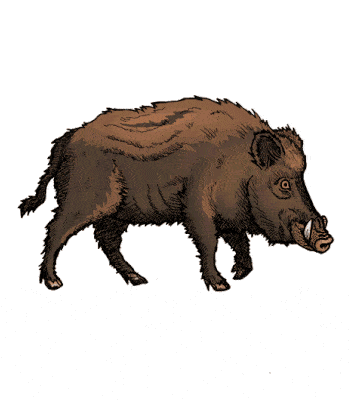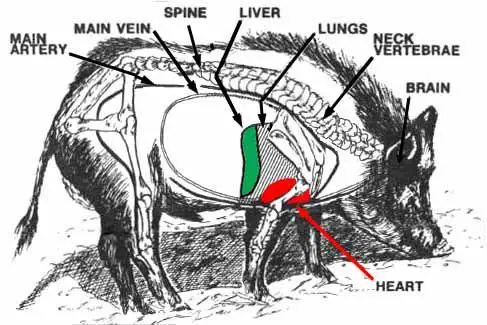As an Amazon Associate I earn from qualifying purchases.
Our Associate portal can be found here
Anatomy of a Wild Hog
Hogs are super-armored beasts that are almost impossible to kill, or so the tale goes. Seasoned hunters of other games have gone hog hunting and ended up empty-handed which further fuels the tale. You may also have placed your red dot, crosshairs, or sights on the perfect kill spot on its body, taken the shot but then it ran off! But no, a wild hog is not impossible to kill with a single shot. The secret lies in understanding the anatomy of the hog.

Kill Zone Areas
The arrangement of the organs within the hog is unlike any other game. Moreover, it’s not only the position, but the vital organs are also much smaller. You, therefore, have smaller targets in a relatively larger body. That’s how it can keep running even after you deliver the seemingly fatal shots. Let’s dive into some anatomy that will enable you to drop a hog with a single shot.
For the ultimate kill shot, you have to aim for the heart, lungs, spine, or brain. They are the proven kill zone areas, and their location and effect are as follows:
The Heart
A hog’s heart is located at the very bottom of the pig’s chest. It lies right behind or through the front leg when you are standing on the broadside. The shoulder blade and muscle do cover over 85% of the heart. A projectile has to pass through the skin, muscle, shoulder plate and front leg partly, layer of fat around ribs that may be calcified, the ribs, and internal soft tissue before getting to the heart. All these deteriorate the bullet/ arrow energy, but it will still be adequate to damage the heart and even emerge on the other side.
To drop the hog instantly, aim at the lower shoulder area at the lowest point of the chest when shooting from the broadside. When quartering to or away, place the shot between the shoulders.
You may need to note that the liver, stomach, and intestines of a hog are pushed more forward than the other animals. A shot behind the shoulder will more likely rapture these organs rather than hitting the heart. The hog will die all right, but hundreds of yards away and you will never get to catch it.

The spine at Neck Region
Another effective kill zone is the spine. It contains the spinal cord, which is the connection between the brain and the body through nerves. That is how the hog controls all its breathing, muscle movement for walking, and other functions of the rest of its body. Hitting the spine at the neck region paralyzes the hog’s body for you to collect your prize. You can also hit the spine on the back, which paralyzes the hind legs, but the most effective one is at the neck vertebrae.
What most hunters don’t know is that the spine at the neck runs way lower through the shoulder section than most people may think. Aim a little lower, as shown in the picture to hit the spine and instantly shut down the hog. It’s best taken when the animal is not running but if you trust your skills, then have a go at it.

Lungs
Above the heart area, you find the lungs. In the lower region, it is pushed forward by the liver, stomach, and intestines while in the upper region, it extends further back. It, therefore, provides you with a larger target.
Aim for the rib cage just behind the shoulder as you will do when shooting down a deer and you will hit the lungs. The downside, however, is that it will run for a couple of hundred yards before dropping down. Unless you have a hunting dog or are in an open area, you may need to avoid this shot.
Brain
Finally yet importantly is the brain shot. It’s located in the hog’s head between the ears. Unlike in other animals, the brain is quite small and surrounded by thick skull bones. Its size and protection, therefore, makes it quite a challenging target, which is the reason it’s placed as fourth in this list. It is, however, the ultimate shot as the hog will drop instantly.
If you are facing the hog, shoot right at the front of its head, above the eyes at the center. From the sides, take your shot through the ears or slightly lower. The prerequisites of a successful headshot are either of the two:
- Exceptional marksmanship
- Shooting from close range
Essential Considerations in Relation to Anatomy
Now that you know where to shoot, you are more than ready to drop some hogs. However, you may also need to understand some additional aspects of its anatomy for immense success during hunting.
Absence of Sweat Glands
Hogs have no sweat glands and therefore cannot cool their bodies through sweating as we do. They have to keep cool through water or feeding when it is cold. You will consequently need to hunt around water areas. They are nocturnal because the night presents them a cool temperature and protection from hunters. Therefore, you will have more luck hunting at night.
Thick Skin
Their skin is thick and has a lot of fat, which may be calcified in some cases. You will need to be within a reasonable distance for your projectile to have enough penetrating power still when it hits the hog. Also, choose your hunting equipment with this factor in mind.
Sensitive Nose
They have one of the most acute senses of smell among all animals courtesy of their sensitive snout. They can pick up scents from as far as 7 miles away and as deep as 25feet underground. Ensure the wind direction is in your direction for you to catch them off-guard. You can also use scent-clearing sprays when hunting from a stationary point.
Muscle Strength
Hogs have powerful muscles, which allow them to run as fast as 25mph. They also weigh between 200lbs to 300lbs and that combined with their speed means you have to have fast reflexes in case you are to take a shot while it is charging.
Eyes
Their vision is excellent, allowing them to see as far as 100yards. However, they are color blind to green and red and therefore use these lights when hunting at night.
Blood
Hogs’ blood forms a plug on the wound within a short time. If you deliver a shot and it runs, you will pick a blood trail for only about 100 yards before the wound is plugged. So ensure you deliver a killing shot or have a good hunting dog to locate it.
Conclusion
Knowing a hog’s anatomy will make you look like a legend to other hunters. A hog is not a large target as many people may think because you have to hit the heart, neck spine, lungs, or brain to drop it. Now you are ready to kill some hogs effectively. Happy hunting my friend!
Amazon and the Amazon logo are trademarks of Amazon.com, Inc, or its affiliates.

36 years old, been hunting and fishing my entire life – love the outdoors, family, and all kinds of hunting and fishing! I have spent thousands of hours hunting hogs and training hunting dogs, but I’m always learning new stuff and really happy to be sharing them with you! hit me up with an email in the contact form if you have any questions.


